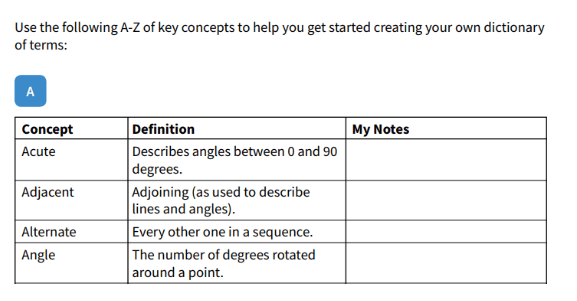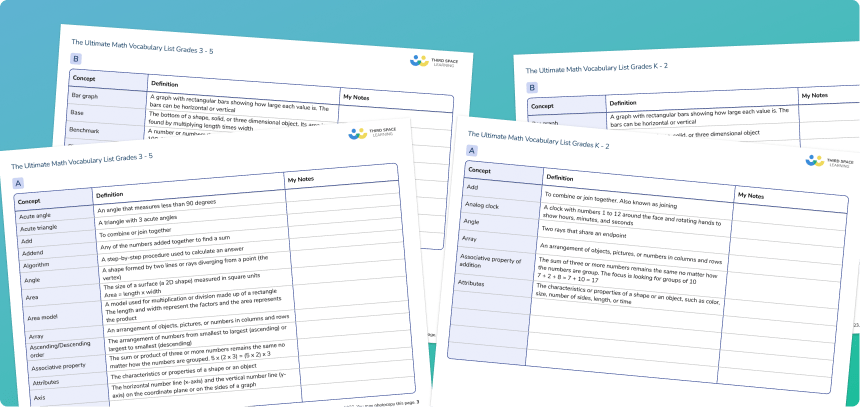The Comprehensive Math Vocabulary List for Elementary School
Like many teachers, you’re probably keen to support your students with their math vocabulary but narrowing down the list and keeping track of what students know and what they don’t know can be hard.
We know how important math vocabulary is in elementary school and earlier. As a related article on mathematical language shows, many problem solving questions on tests involve quite a complex and nuanced understanding of math terminology, even before you’ve attempted to answer the question.
Ultimate Math Vocabulary Lists
Download this free math vocabulary list for Kindergarten through to 5th grade
Download Free Now!At the start of each of our online one-to-one math tutoring lessons, our math tutors will recap all the keywords for the topic, just to establish what the children know already, and to understand how much support will be needed.
This is similar to what you will do every day in your math lessons or in your knowledge organizers, with the key words on the whiteboard or highlighted clearly.
The challenge sometimes in math can be ‘which key words’ to choose. That’s why we’ve created a starting point for you – a comprehensive list of the math vocabulary words that all elementary school children should know before middle school.
What’s in our Third Space Math Vocabulary List?
The math vocab list is definitely just a starting point for your students’ adventures into the marvels of mathematical language.
We’ve deliberately kept it to the most important words both to focus students’ attention and to give time and space for children to add their own definitions and explanations as well as any additional terms that they need to remember for each grade level.
Children are much more likely to remember the meanings and terms of mathematical words and phrases if they have constructed the pages for themselves. They can choose vocabulary which reflects their age range, and once made, the dictionary can be accessed and used frequently in math lessons.
Math Vocabulary List

Your students’ A-Z of math terms and their definitions could include:
2D shape, 3D shape, Acute, Addition, Adjacent, Alternate, Angle, Area, Area model, Ascending order, Associative property, Attribute, Average, Axis of symmetry, Baker’s dozen, Base, Base angles, Bisect, Capacity, Cardinal number, Circumference, Commutative property, Composite number, Congruent, Consecutive, Coordinates, Decimal, Decompose, Denominator, Descending order, Diagonal, Difference, Digit, Dimensions, Distributive property, Division, Dodecagon, Dozen, Edge, Equation, Equilateral triangle, Equivalent, Estimate, Even number, Expanded form, Exponent, Expression, Exterior, Face, Face value, Factor, Fraction, Greater than, Heptagon, Hexagon, Horizontal, Improper fraction, Integer, Interior, Intersection, Irregular shapes, Isosceles triangle, Length, Kite, Less than, Line of symmetry, Mean, Median, Mixed number, Mode, Multiple, Multiplication, Numerator, Oblong, Obtuse angle, Octagon, Odd number, Order of operations, Ordinal number, Parallel lines, Parallelogram, Parentheses, Partial product, PEMDAS, Pentagon, Perimeter, Perpendicular line, Place value, Polygon, Polyhedron, Prime number, Product, Quadrant, Quadrilateral, Quotient, Rectangle, Rhombus, Right angle, Rounding, Scalene triangle, Square number, Squared, Standard algorithm, Standard form, Subtraction, Sum, Symmetrical, Trapezoid, Vertex, Vertical line, Whole number, Width, Word form.
How to use your math vocabulary list
To really embed students’ knowledge of new math terminology, we recommend you encourage them to build their own math vocabulary list. You can use our list or parts of our list as a prompt to get them started, build math sentence stems or hand out a vocabulary list in full and encourage them to add to it.
As teachers, however, we need to make sure they’re remembering the correct words and definitions. As you will know from cognitive load theory, practice makes permanent, so we want that practice to be the correct information.
To accompany this list, we’ve also produced a really excellent article on how to embed math terminology in your class. This looks at the confusion that arises around math terms with dual meanings, or ones we use imprecisely.
Your math vocabulary list will be essential to support your work developing students’ knowledge and understanding of math words.
Why you need a math vocabulary list in your classroom
- A math vocabulary list provides a focal point for your students to use every day with agreed definitions. Having one centralized math vocabulary list that students can become familiar with can prove invaluable as part of their math reasoning work.
- The math language in your vocabulary list is crucial to prepare students for middle school. The terms and phrases will come up throughout middle school and beyond.
- It is a great way to keep track of current knowledge levels and gaps in math understanding in your class. Knowledge levels will vary from year to year based on what has been covered previously, but you will soon see if there are any areas that are still a mystery to students and be able to take action to help them achieve.
- We suggest including space for note taking within the resource to enable students to actively engage in creating their own definitions and ways to remember the words.
Ideas to improve math vocabulary include:
- A math word of the day which teacher and students should aim to use
- Encourage math journal writing; this math mastery toolkit has more information about math journals.
- Looking specifically and recording in their math journals math vocabulary that they encounter in everyday life with a different meaning
- Make learning new words fun through activities such as: making foldable shapes, creating word walls and pictures and publishing student-led videos about shapes.
- If your class responds well to this kind of stimulus, then find a rap, or song on YouTube to help them remember.
- Try out some of these math vocabulary games and activities using the math terms on the list.
Set out in an easy to follow A-Z structure, the list covers words and phrases from all elements of the math curriculum, with easy to follow definitions.
With so many mathematical words being used in the classroom, it is important for students to have a place to store all of this information, and that is why we made this comprehensive list of math terms!
More articles to support your math mastery work at school
- What is Math Mastery?
- How To Use the Concrete Representational Abstract Approach In Elementary School
Don’t miss our math dictionary for kids either which includes links to fuller definitions, with examples and sample questions on terms like quadrilaterals, right angle, 3D shapes, cuboid, common factor, venn diagram, x-axis and y-axis.
Do you have students who need extra support in math?
Give your students more opportunities to consolidate learning and practice skills through personalized math tutoring with their own dedicated online math tutor.
Each student receives differentiated instruction designed to close their individual learning gaps, and scaffolded learning ensures every student learns at the right pace. Lessons are aligned with your state’s standards and assessments, plus you’ll receive regular reports every step of the way.
Personalized one-on-one math tutoring programs are available for:
– 2nd grade tutoring
– 3rd grade tutoring
– 4th grade tutoring
– 5th grade tutoring
– 6th grade tutoring
– 7th grade tutoring
– 8th grade tutoring
Why not learn more about how it works?
The content in this article was originally written by Ofsted inspector and teacher John Dabell and has since been revised and adapted for US schools by elementary math teacher Katie Keeton.





